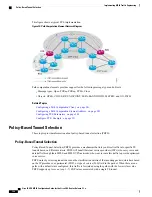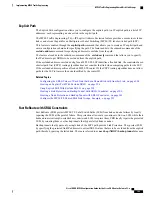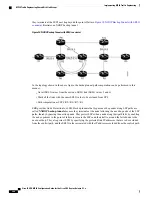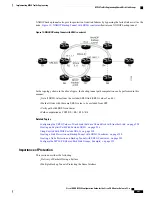
they terminate at the LSP's next hop beyond the point of failure.
Figure 18: NHOP Backup Tunnel with SRLG
constraint
illustrates an NHOP backup tunnel.
Figure 18: NHOP Backup Tunnel with SRLG constraint
In the topology shown in the above figure, the backup tunnel path computation can be performed in this
manner:
•
Get all SRLG values from the exclude-SRLG link (SRLG values 5 and 6)
•
Mark all the links with the same SRLG value to be excluded from SPF
•
Path computation as CSPF R2->R6->R7->R3
FRR provides Node Protection for LSPs. Backup tunnels that bypass next-hop nodes along LSP paths are
called
NNHOP backup tunnels
because they terminate at the node following the next-hop node of the LSP
paths, thereby bypassing the next-hop node. They protect LSPs when a node along their path fails, by enabling
the node upstream to the point of failure to reroute the LSPs and their traffic, around the failed node to the
next-next hop. They also protect LSPs by specifying the protected link IP addresses that are to be excluded
from the explicit path, and the SRLG values associated with the IP addresses excluded from the explicit path.
Cisco IOS XR MPLS Configuration Guide for the Cisco CRS Router, Release 5.1.x
200
Implementing MPLS Traffic Engineering
MPLS Traffic Engineering Shared Risk Link Groups





































